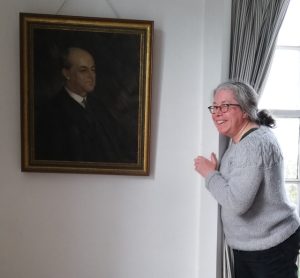In which the President encounters not one but three past Presidents, faces up to her personal odd-struckness, and gets excited about school.
I have made references in these blogs encountering past Presidents of the Central Council, and this one has three. Over Easter, we had a handbell-based holiday at the former home of Edwin Lewis. He was President from 1930 to 1957, which represents some serious dedication. As we viewed the tattered remains of several peal attempts and were tempted out of doors by the fleeting bursts of sunshine (the house is located on the west coast of Scotland), an interview from Robin Hall dropped on the handbell blog.
In it, he said he didn’t like ringing handbell peals, because quarter peals were more sociable. Peals ate into the wine and cheese time. This caused quite a lot of discussion. When one identifies as a peal ringer, admitting that a shorter length is sometimes more fun is a big step. It felt shocking, brave, and liberating.
I am starting to see other examples of different bands and associations, testing assumptions and trying some new things. One such is the launch of the Ranmore Ringing Club. This is a clever initiative to get more use out of the additional training facilities put into during a tower refurbishment. The Club invites ringers to say what method they want to practice, and then pulls together a small group of similarly interested to make a training session. A modest charge is made per session (which older ringers might recognise as a ‘steeplage’). Can’t wait to hear more about it.
While listening to the latest Fun with Bells podcast, (highly recommended and not just because I’m in it), I was struck afresh at Max Drinkwater’s reminder that churches can be of use to bellringers in areas where we might struggle for expertise or assistance. He gave examples of safeguarding, communications and especially roles dedicated to building relationships with schools and other communities. As bellringers we talk a lot about the mutual benefits between us and the churches where most of ring – but how much do we remember to make use of that relationship?
We tend to think we need to do everything ourselves – this is no doubt a huge relief to otherwise beleaguered churches, but it also makes us a little bit invisible. It also makes us a little bit unhelpfully stubborn. If your local church or diocese has a communications or outreach officer, why not get in touch and discuss how bellringing can help with their plans?
Helping to bring that mutuality to the surface is a key message of Bell Sunday, and I’m looking forward to reading about your activities soon. Once a year isn’t enough. Like all good relationships, it takes work to maintain.
The importance of this relationship was underlined by a presentation to the Executive by Alison Hodge and Simon Linford (past President number two), who have been researching the implications of closures of church buildings – where most of our rings reside. You will have seen references in recent issues in The Ringing World – both from the excellent article on the Lincoln Diocesan Guild and a letter from Simon Linford. Although the presentation was sobering indeed, it was powerful to see the challenge before us so clearly evidenced. More on this to come, I assure you.
Alison’s and Simon’s presentations came at the end of an inspiring Executive meeting, where we heard progress summaries from all the workgroups. This will be a regular feature of the monthly executive meetings, and we will add these short updates to the website as well – check it out here: https://cccbr.org.uk/ringing-2030/
One of the more exciting projects has been restarted – which is developing lesson plans based on bellringing for schools. Another phase of trials is coming up in June, and one of the trials will also make use of the new Touring Tower – immersive education indeed.
We know our traditional recruitment stream for young people – via the church – is yielding fewer and fewer new ringers. Normalizing bellringing within the school curriculum has the potential to be a powerful source of recruitment, especially if we can pair this with a clear destination to a learning centre.
Sounds like a lot of work? It is. A lot of work has already gone into it, and to do the thing properly, the project will need a team to sustain it. The same goes for many of the Ringing 2030 projects currently being undertaken. Andrew Howard has been wondering how this is all done with a team of volunteers on a shoestring budget. The answer is with a lot of goodwill, and with some acceptance that not everything is super-polished, or super-prompt.
Is that enough? Important roles remain unfilled in almost every association (and indeed in the Central Council). Carrying on as before and hoping for the best isn’t going to cut it. The problem with carrying on as we had before is that we get used to it and stop noticing when it isn’t working. I was brought up hard against this when someone commented on some odd-struckness in the tenor at Glasgow. Really? I thought. Surely not, i thought. I’d have noticed, I thought. Instead I got a demonstration of my personal odd-struckness on a recent ringing outing to London. Yep, I had gotten too used to my own bells.
I promised you three past Presidents, and I found the third in the form of Chris Mew’s name on a pealboard at West Hill, Wandsworth. The story is that this peal silenced the bells for 25 years. It’s a good story, but maybe I had better let Chris tell it (spoiler – it wasn’t really their fault).
Send to a friend
